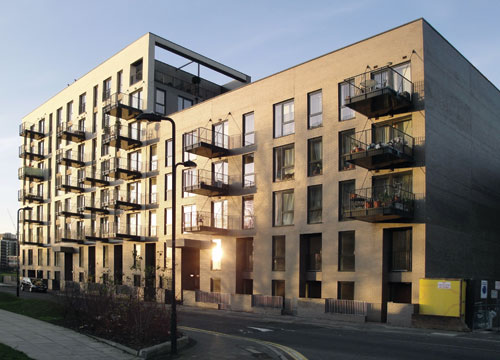Tall Wood Takes a Stand
Project: Bridport House |
||
When it was completed in 2011, this eight-story structure formed the largest timber-built apartment block in the world. Built using a conventional platform-based CLT system, the structure included 41 new homes in two joined blocks; one eight-story building and the other five stories. All elements from the ground floor up were of CLT, including the elevator shaft. As is typical of these buildings, the below-ground level was of reinforced concrete but the ground floor was CLT. Developers chose to use wood for Bridport House for several reasons: structural capabilities of CLT, speed of construction, and environmental advantages. The project was built over an old sewer line that runs through London; the line is big enough to drive a double-decker bus through but could not sustain the loads of a heavy concrete building above. Wood's light weight allowed the developer to maximize use of the site while still meeting below-ground requirements. In fact, the structure was twice as high as the previous building, while the weight increased by only 10 percent. On-site assembly took just 12 weeks, primarily because the CLT panels were prefabricated off-site and then lifted into place. EURBAN, the project's timber engineer, estimates that on-site assembly time was 50 percent faster than conventional reinforced concrete. The environmental benefits of using wood for Bridport are also noteworthy. If the building had been constructed of conventional reinforced concrete, the materials required would have incurred an additional 892 tons of carbon; that's equivalent to 12 years of operational energy required to heat and light all the dwellings at Bridport House. When the sequestered carbon locked up in this timber structure is added to the amount of carbon avoided, the total figure is 2,113 tons of carbon—equivalent to 29 years of operational energy. Plus, because of the thermal benefits afforded by a CLT building system, the structure's airtightness measured three times better than that required by local Building Regulations.16
|
| ENDNOTES | |
| 1 | Life Cycle Environmental Performance of Renewable Building Materials in the Context of Building Construction, Consortium for Research on Renewable Industrial Materials, Phase I 2005, Phase II 2010; A Synthesis of Research on Wood Products and Greenhouse Gas Impacts, Sarthre, R. and J. O'Connor, 2010, FPInnovations; Wooden building products in comparative LCA: A literature review, Werner, F. and Richter, K., 2007, International Journal of Life Cycle Assessment, 12(7): 470-479 |
| 2 | Carbon 101: Understanding the Carbon Cycle and the Forest Carbon Debate, Dovetail Partners, Inc., 2012 |
| 3 | The Case for Tall Wood Buildings, mgb ARCHITECTURE + DESIGN, Equilibrium Consulting, LMDG Ltd., BTY Group, 2012 |
| 4 | Rethinking Wood as a Material of Choice |
| 5 | Structural Composite Lumber (SCL): A Practical Alternative, APA - The Engineered Wood Association, 2012 |
| 6 | Glulam: Visible Beauty, Hidden Strength, APA - The Engineered Wood Association, 2012 |
| 7 | Tracking Industrial Energy Efficiency and CO2 Emissions, International Energy Agency, 2007 |
| 8 | Cree Buildings, Inc., The Natural Change in Urban Architecture, www.creebuildings.com |
| 9 | Calculating the Fire Resistance of Exposed Wood Members, Technical Report 10, American Wood Council, 2003 |
| 10 | Multi-Story Wood Construction, A Cost-effective and Sustainable Solution for Today's Changing Housing Market; K. Tetlow, WoodWorks and reThink Wood, March 2012 |
| 11 | Wood-Concrete Hybrid Construction, Canada Wood |
| 12 | CLT Handbook, FPInnovations, 2011 |
| 13 | A Strategic Plan for the Commercialization of Cross-Laminated Timber in Canada and the U.S., Canadian Wood Council, 2010 |
| 14 | CLT Handbook, FPInnovations, 2011 |
| 15 | Forté Case Study, Lend Lease, 2012 |
| 16 | Bridport House Case Study, Willmott Dixon, 2011 |
 |
The reThink Wood initiative is a coalition of interests representing North America's wood products industry and related stakeholders. The coalition shares a passion for wood and the forests they come from. Innovative new technologies and building systems have enabled longer wood spans, taller walls, and higher buildings, and continue to expand the possibilities for wood use in construction. www.rethinkwood.com |









